I can’t fully explain why we wanted to go to Mongolia. Of all the places in the world, most people would rather visit another country. Many of our family members were amongst those that politely asked why, and our answer was something vague, such as “It just looks interesting.”
Our trip would take us on a two month journey through China and Mongolia, of which we spent almost three weeks in Mongolia. Most of that time was spent on a 15-day tour of the Mongolian countryside in an old beat-up Russian army van, now repurposed to carry tourists across the rugged terrain. We would spend most of our journey in this old nearly broken-down van while camping in the countryside, eating very fresh meat, and meeting the locals.
Find Beijing Hostels Near the Forbidden City
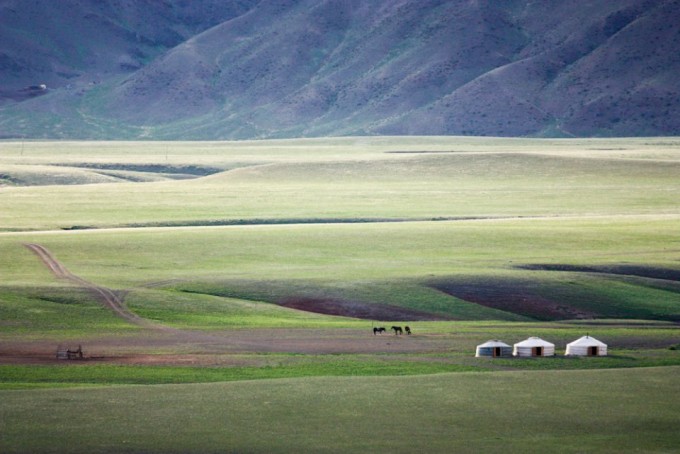
We arrived in Ulaanbaatar, Mongolia’s capital, after a long journey. From central China, we had a long bus ride to the Mongolian border, and then caught an overnight train at the border to UB (travelers referred to Ulaanbaatar as “UB”). After arriving in the morning, we found a guesthouse-hostel in the middle of the city that also ran tours, so we signed up for a tour with some other travelers in order to split the costs.
After a good night’s sleep and stocking up on some supplies, the next morning we started our adventure by heading south into the Gobi Desert. With us was Dave from Australia, Sofie from Stockholm, and Euan from Scotland. We also had a guide, Suvdaa, and a driver, Dasha. We were all seated comfortably in our blue sturdy four-wheel-drive retired Russian army van. It looked like it was about to break down, but it was all part of the adventure. In the back of the van was all of our camping supplies and food. The plan would be to camp about half of the time, while staying in gers the rest of the nights (either with families or in gers set aside for tourists).
A ger is a large, round nomadic tent. We commonly know of these tents by their Russian name “yurt”, but “ger” is the Mongolian word. While half Mongolia’s 2.9 million people reside in Ulaanbaatar, the other half lives a nomadic lifestyle in the countryside. Permanent structures outside of the infrequent small towns are hard to find. Most families living out in the wild have between two and six gers clumped together in one spot for a season while their herds graze on the nearby grassland. These Mongolians living in the countryside are nomadic, but they only move two or three times per year.
Mongolia is vastly empty. With a total land area larger than Texas, California, and Montana combined, its total population is that of a medium sized city (half of which live in the capital). Not only that, but Mongolia is also devoid of trees, with only 6% of the land being forested. The result is eerie and quiet. The north is dominated by rolling hills covered in lush grass (the “steppes”), while the Gobi Desert in the south marks the landscape with vast flat areas of shrubby sand and distant mountain ranges.
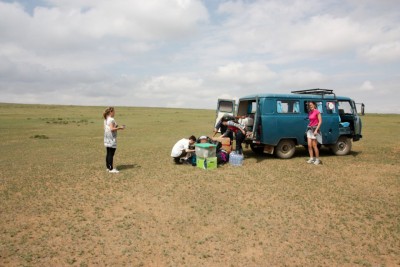
At the beginning of the tour, our guide Suvdaa asked us if we ate meat. We all said yes, but soon realized this may have been a mistake. In the next town, Dasha the driver went into a small shop and soon emerged with a large and dirty cardboard box under his arm. We weren’t really sure what was in the box, but he threw it into the back of the van with all of our bags, camping supplies, and food.
We then drove for about 8 hours, stopping at various rock formations and small lakes along the way. We knew the first day would be mostly driving to get down to the Gobi. We finally stopped at an interesting rock formation as the sun was getting lower in the sky. This is where we would camp for the night. Around dinner time the grungy cardboard box came out of the van. Suvdaa then reached inside and pulled out a very fresh leg of lamb. She held it by the foot, as it was still slightly bloody. She cut off some pieces of it to include in the stew she was making for our dinner, and then put the rest of the meat back into the box. Then the box went back into the van. This happened again with each meal. A few days later we were still eating the same meat out of the same cardboard box. No, there was not a refrigerator in the van. When we ran out, we bought another leg in the nearest town and threw it into the box. Basically, for two weeks we drove around Mongolia with a dirty cardboard box full of raw meat in the back of our derelict Russian van.
On that first day of our trip, as we drove south out of Ulaanbaatar towards the Gobi Desert, we noticed that soon the roads of the city transformed into dirt roads, and then just grassland with tire tracks, and then the tire tracks vanished as well. Most of the country has no roads. We watched the landscape change from grass-covered rolling hills to flat rocky desert, and then to grassy desert. We camped at a beautiful spot around some large boulders, watched the sunset, ate meat from a box, and figured out where to use the bathroom in a country without buildings or trees.
Normally when camping, it’s not hard to find a place to use the bathroom; just step into the woods for a bit and find a tree. However, Mongolia doesn’t really have any trees. Men went to the left side of the van, and women to the right.
On the second day we drove through a sandstorm. It was insane. We saw it coming, it was impossible to miss. It was a huge wall of red clouds coming towards us. Dasha, our driver, just took us straight through it. Even though we were in the van, we could smell it and the air became dusty. After twenty minutes or so, we finally broke through it. While we were all mesmerized during the storm, Dasha later told us that he had never seen a storm that intense in 20 years.
Eventually the sandstorm turned into a cold rain, and as it was getting late in the day, we looked for a place to stay. While the original plan was to camp, our driver and guide decided to head to a tourist ger camp, which was basically like a hotel made from nomadic tents. When we arrived, the ger camp was full with a few other tourist groups that had the same idea to escape the cold rain, so we had to look for a nearby family to stay with. We ended up at the home of a family that herded camels. They had 2 gers and warmly welcomed us into their home. Mongolian custom dictates that they immediately share some of their food with guests. They gave us milk tea made from fresh camel’s milk. It was essentially boiled milk straight from the camel with lots of salt and a little tea mixed in. They also had us taste some of their airag, which is fermented milk from whatever animal you happen to have nearby. In this case, it came from a camel. The frothy drink tasted like sour yogurt. Or, more accurately, it tasted like milk that has sat out in the open for three days. Supposedly the camel milk was better for making these products than the horse milk used in the northern parts of Mongolia. That’s what they said, anyway, but I think they were biased because they were camel herders instead of horse herders. Along with these dairy products, they also served us some sweet homemade cookies. We ate a very large amount of these cookies between small sips of tea and airag.
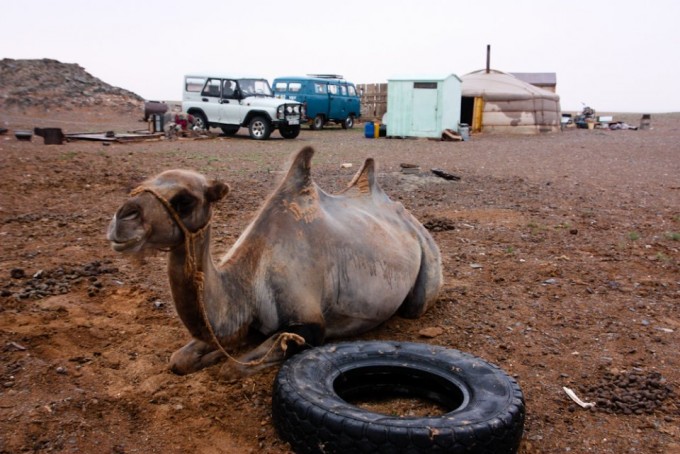
After our introductions and drinks, the family gave us a tour of their ger. This was our first ger experience, so we didn’t know what everything was. The round tent was about twenty feet across. It contained two beds, some shelves, a small stove which burned camel dung (since there were no trees nearby), and a Buddhist alter at the back. The men’s side was on the left and the women’s on the right. The stove was in the middle and next to it sat a very small table and a few short stools. A few times each year, they pack all of this stuff up, and move somewhere else so that their herd can have a better pasture to graze on.
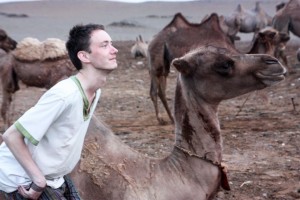
After the tour of the ger the rain had finally stopped, so we went outside to take some photos. The camels were tied up to some rocks and tires not far from the gers, and the only other objects around were our van and the family’s truck and motorcycle. Digital cameras are a great ice breaker, and the family was very excited to have their photos taken and then see themselves on the little electronic screens. They wanted to pose themselves, and us, in front of the ger, the camels, and their old Russian army jeep in a variety of different ways. Each photo led to even more laughter. Euan from Scotland did a very good impersonation of a camel, and this excited the Mongolians into a hysterical frenzy. Despite their smiles and excitement, very few of them actually smiled for the photos. So, all of our pictures of the family make them seem like very serious and rugged people. I guess this is appropriate, because they do actually live in the middle of nowhere in the Gobi desert in a little round tent surviving on camel milk. And gers don’t have toilets, either.
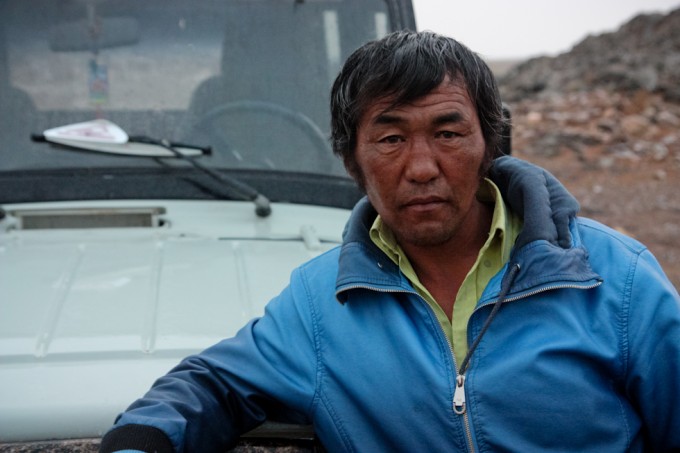
On the third day we said goodbye to the family and drove further south into the Gobi. We stopped at a small town to take a shower at one of the many public shower buildings in the country. (These exist because gers also don’t have showers.) Then we made our way to a ger camp set up like a hotel for tourists. We had our own ger, this time without a family in it to serve us homemade dairy products. The surrounding landscape was stunning, filled with green rolling hills backing into a large mountain range. We had come out of an area of desert and back into lush steppes. In the distance, gers dotted the green landscape and herds of sheep, camels, and horses could be seen slowly moving across the land.
With the help of Suvdaa to translate, I asked our driver how he knew which direction to go. There were no roads and he didn’t seem to have a map. I asked if he had a GPS, but he just put his finger on his head and Suvdaa said that his memory was his GPS. Dasha was an older man, about 60, with a large belly and an even larger smile. He used to drive trucks around Mongolia before moving into the seasonal summer tourist business.
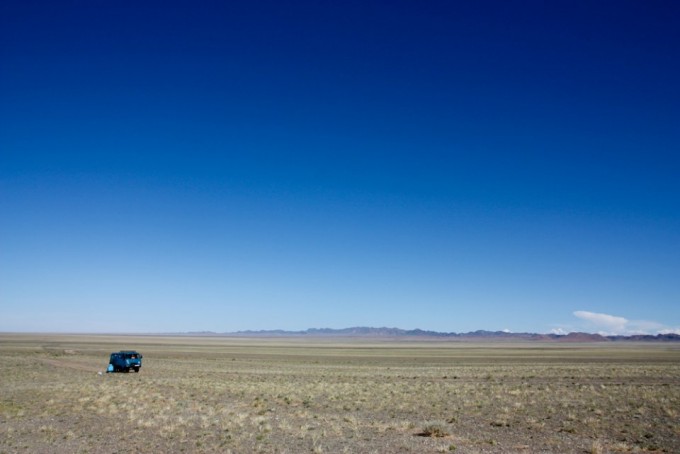
On day 4 we hiked through the Ice Canyon, where ice exists year-round due to cold weather and steep cliffs that block the sun. It was a lot of fun, although very slick at times. Eventually the canyon opened up into a valley where the ice vanished, and we camped at the end of the day in a nice spot near a creek. Dasha had driven the van around to the other side of the canyon so that we could have access to our tents and eat from our cardboard box of raw meat.
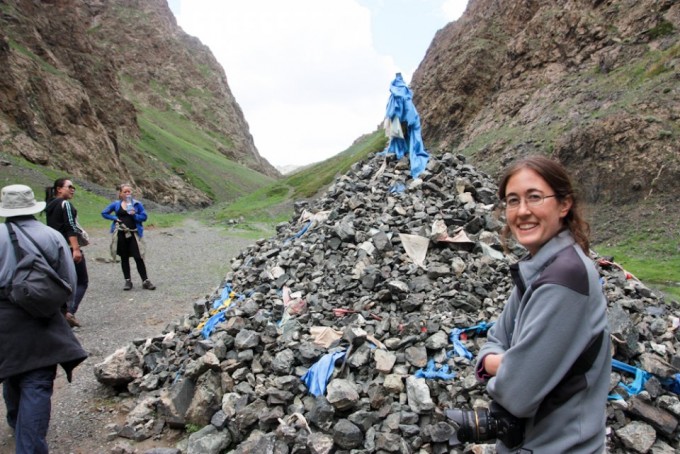
On day 5 we drove to the Red Cliffs to have lunch. Many dinosaur fossils were discovered in Mongolia, mainly around the Red Cliffs area. We were fully into the Gobi now, and the region looked similar to some parts of the Southwestern United States, with orange and red layers of earth forming various rock formations. There was a small ger set up as a museum with a few dinosaur bones and other native animals on display, taxidermist-style. They also had dinosaur eggs on display.
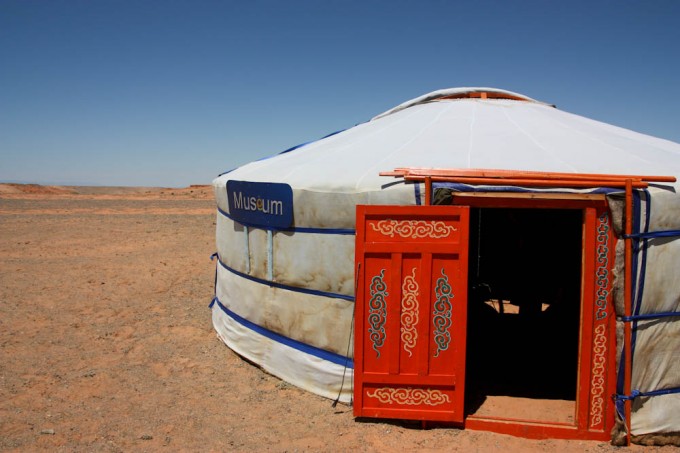
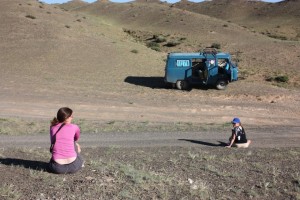
After lunch we drove west towards the Singing Sand Dunes, an area where sand dunes have taken over the more grassy part of the desert. On the way, however, our van broke down. Dasha started to dismantle one of the rear wheels as the rest of us watched with growing worry. We were in the middle of nowhere, and the dirt trail we were following was merely a suggestion. An incident like this can turn into a disaster. A few minutes stretched into an hour. Eventually he had dismantled the entire wheel. He then pulled out a large bag and dumped its contents onto the ground. It was his bag of spare parts, and it contained thousands of tiny metal pieces: nuts, bolts, screws, ball bearings, springs, and random other pieces, but not a single one was identical. It looked like some little child had dumped out his entire collection of Legos onto the floor. Our hopes for repair sunk another notch lower. “We’re gonna die out here,” someone said (probably me).
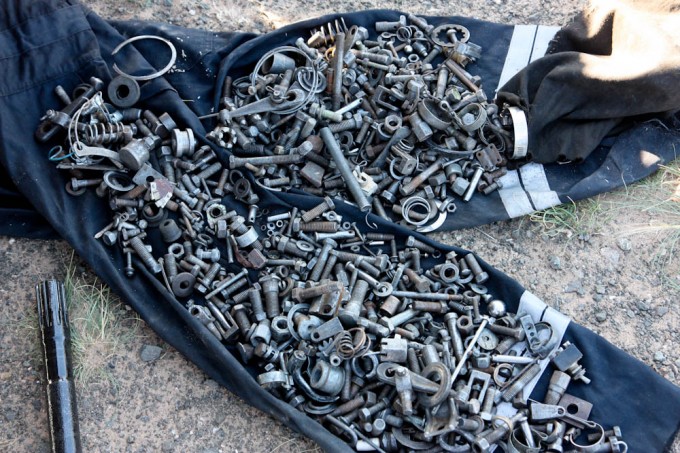
Eventually he put the wheel back together and we drove down the valley. Apparently after all of that, we could still drive on it. But Dasha was very worried and driving slowly. We soon came across a family living in a ger, and parked next to their ger was a van exactly like ours! There was much discussion in Mongolian, but then we left without any spare parts or a new wheel. But soon enough it was fine, because after driving a few minutes more down the valley we came to a tourist ger camp with yet another old Russian van sitting out front, but this one was in shambles. With the help of some locals, Dasha took the wheel off of it, gave someone some money, and off we went. He had a huge smile on his face, and we were all relieved.
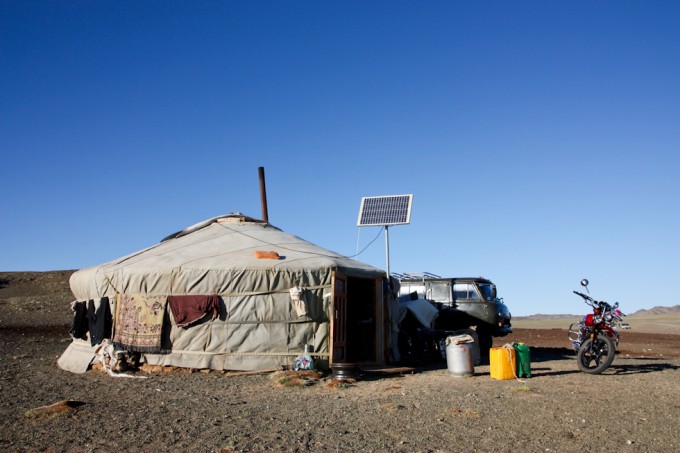
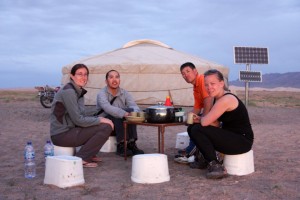
After another hour of driving (slowly) we arrived at a flat area nearby the very large sand dunes. Once there, we stayed with a family who ran a tourist ger camp and owned a large herd of camels. We had our own hotel-style ger to sleep in, but were invited spend a lot of time with the family in their gers. Dasha began to fix our van’s wheel soon after the introductions were made. The Mongolian man who was our host lived with his wife, his wife’s sister, and 3 young sons. The boys were excited to have visitors and brought out their jump rope and soccer ball for us all to play with. More dairy products and digital photos were shared.
That night we all stared at the stars. Being in the middle of nowhere, I could see more stars than I ever thought possible. A large band of stars was clearly visible across the middle of the sky: the Milky Way.
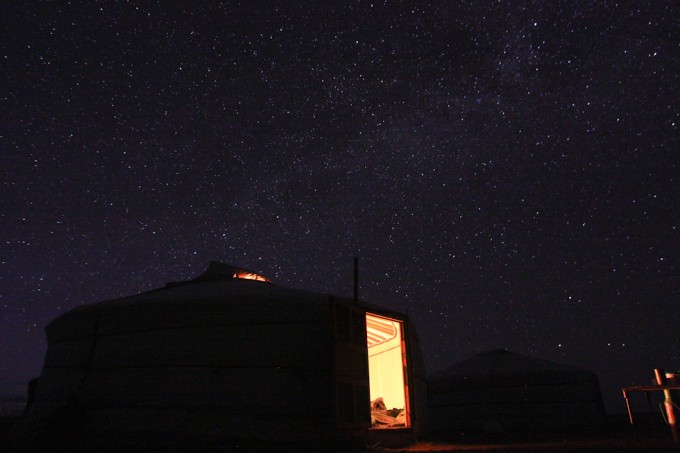
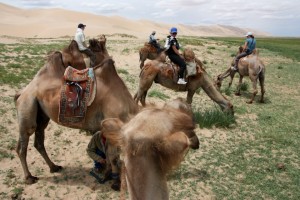
The next day (day 6) we mounted up on the camels and the man guided us to the sand dunes. After riding for a while, we were reminded what it feels like to ride a camel. Asian camels are two-humped, unlike those in the Middle East and Africa. They also have longer hair, and tend to sneeze in your face if you make eye contact. After riding for a while we dismounted at the dunes to relieve our butts and climb to the top of the dunes for a good view. Walking on the sand was like being at the beach, but without any ocean. Climbing became a challenge as we sunk into the sand, but we eventually made it to the top to view the surrounding desert and mountains. We then had lunch back at the bottom before making our way back to the ger camp on our camels. The journey back was longer because we took the scenic route. We had to cross a stream, but the camels really weren’t motivated for the task. Laurie’s camel threatened to stay behind permanently. After much yelling by both humans and camels, we eventually made it back to the camp.
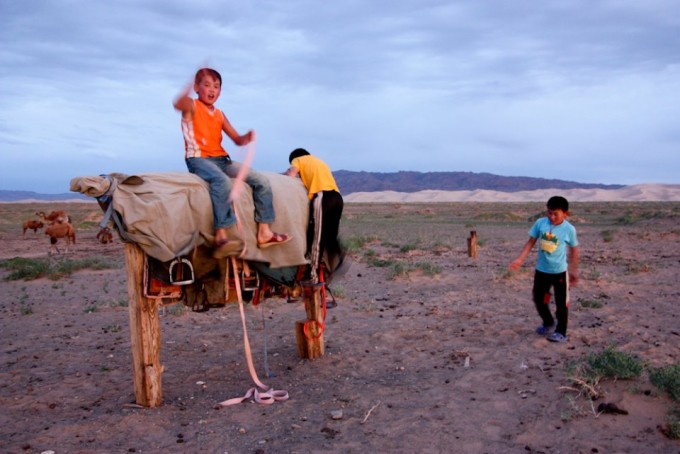
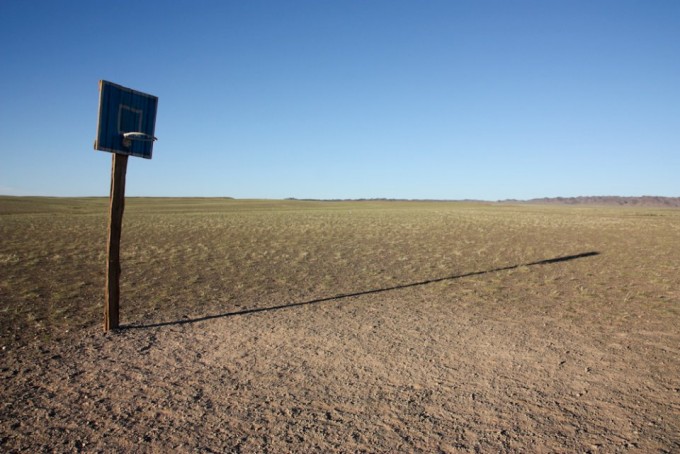
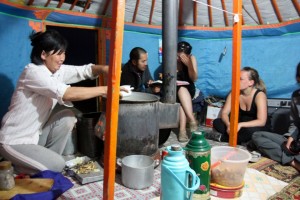
Dasha had completed repairing the van during our camel excursion to the dunes, and the next morning we were ready to hit the road. That day we drove a very long way, all the way from the southern part of the Gobi desert up to the central region of the country where the land is full of green pastures and rolling hills. On the way we stopped for another shower, this time with modern toilets! We eventually arrived at the gers of an extended family with lots of small children running around. This is where we would spend the night. But first, we were to eat yet even more very fresh dairy products, as is the custom when staying at a family’s ger as a guest. Now that we were out of the desert, the milk products came mostly from horses, but also goats and sheep. A true connoisseur would have been able to taste the difference.
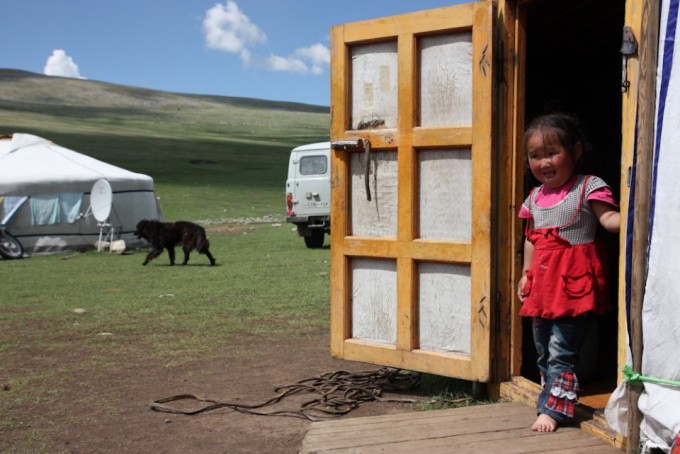
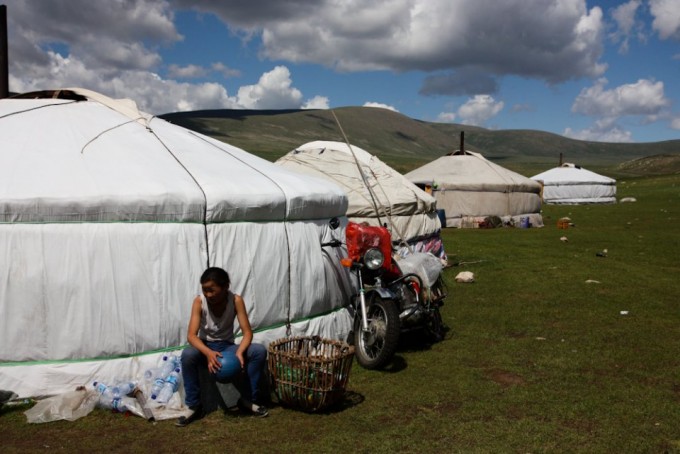
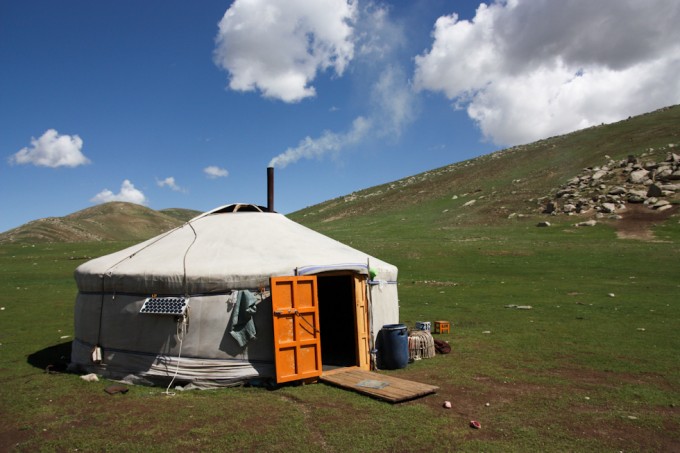
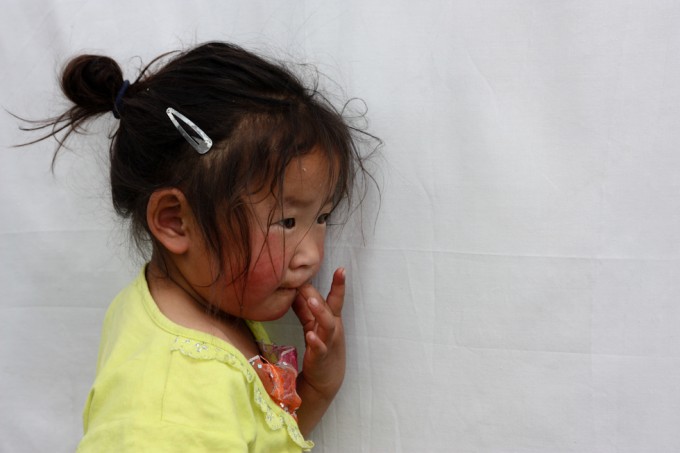
The eighth day was the first of a four day trek through the Eight Lakes region. It became known as “walk-walk-horse-horse” as our guide referred to it, and meant that the first two days of our trek would be on foot, while the second two days would be on horseback. We had heard from other travelers that the Eight Lakes region was absolutely beautiful, so we had high hopes. When we arrived, it was so beautiful that it even surpassed our expectations. We hiked up a slowly inclining hill, ate lunch, and then passed over a ridge yielding a terrific view over the first lake. The surrounding land was covered in lush fields with rolling hills and the occasional small pine forest. A few hours later we arrived on the far side of the lake to set up camp. By then it had rained suddenly and became very cold. So we quickly set up our tents and started a fire.
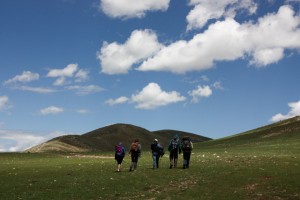
In addition to Suvdaa, the local family sent a guide along with us to manage the horses that were carrying some of our camping supplies. This guide was a young man of about 18 years of age. We were told that he was famous because he was the winner of the horse race at last year’s Naadam Festival. Can you imagine if the most famous athlete you knew was your tour guide through one of our country’s national parks?
The next day we hiked around several more lakes through rolling hills filled with wildflowers, open fields, and pine trees. The scenery was like nowhere else we’ve ever visited. Only 6% of Mongolia is forested, so the views through the open fields seem to spread out forever.
We eventually arrived at the camp of another family which would be our hosts for the night. Horses, yaks, sheep, and goats wandered in the surrounding fields while the family’s ten children tended to dinner and chores. We soon learned that the mother of the family had given birth to all ten children right there in the second ger from the left (the one with the satellite dish and solar panel).
A nearby rocky area was designated as the toilet zone. However, a large white yak in the rocky area seemed very curious as to why we kept intruding into its grazing territory. During one of my private moments that evening, I seriously thought the yak was about to charge towards me while I was doing my business.
Did I mention that gers don’t have toilets? This would not have been such a big deal if there were trees. It also would not have been such a big deal if they didn’t insist that we try the local variety of fermented mare-camel-goat-yak milk with each visit. At one point while we were all riding in the van, Sofie from Sweden asked us, “Has anyone done the second thing?” We had no idea at first what she was asking, as English was not her first language. “You know, the second thing,” she said as she made a rather humorous motion with her arms and legs. After a while, we figured it out: “number two.” No one had done number two yet, as we were all constipated. It was better than the alternative, though.
The next morning (day 10), several men with lots of horses arrived at the ger camp. We put our backpacks onto some of the horses, and then mounted ourselves onto the rest with help from the Mongolians. Then we rode off over the hills through more spectacular scenery. It rained again briefly, but by now we were prepared. However, we were not prepared to have our horses running at a trot almost the entire way. Mongolian horse saddles are not quite like the ones that we use at home (not that we really ride horses very often). After a few hours, the horseback riding went from uncomfortable to outright painful. It must have shown on our faces, because soon one of the Mongolian men leading our group came back and told us to go faster, and that we should be riding our horses like a real man would. You know you’re in trouble when you’re in the middle of nowhere and a Mongolian is insulting your manhood.
Just before the rain came back, and just before our butts couldn’t take anymore punishment, we arrived at the next ger camp. This turned out to be the home of the men that were guiding us on the horses. Six gers were sitting in the middle of an open pasture surrounded on three sides by tall hills, and on the fourth side by a small lake and a pine grove. Horses and other livestock roamed the slopes, adding to the surreal scene. If I was a nomad, this is where I would have put my ger. It was perhaps the most picturesque spot we had visited so far.
As we met the extended family of husbands, wives, and small children running around, it began to rain. We were supposed to spend that night in a tent, but our guide Suvdaa asked the family if we could sleep in the gers instead. Because it was not already included in the cost of our tour, we each had to pay an extra 2,000 togrog (about $1.60) to the family. It was definitely worth it to stay warm and dry. They even had an outhouse instead of some large rocks!
The next morning (day 11), we were supposed to get up early, mount up, and ride out. But the rain started early and lasted for several hours, so the family and our guide decided we should all just lay low for a while and relax in the gers. Eventually the rain stopped, so we wandered outside and played more games with the children.
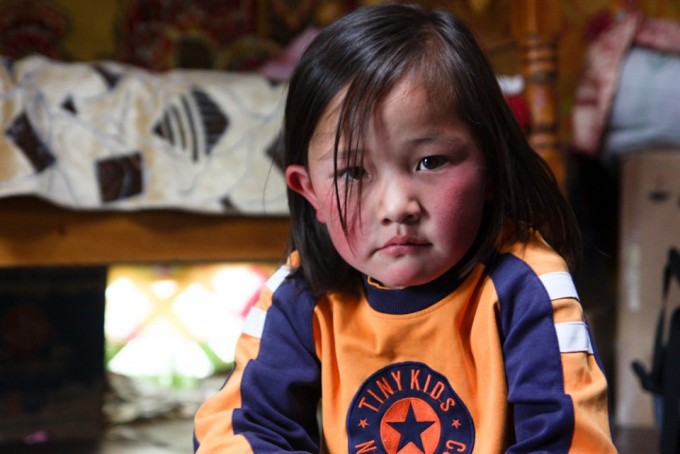
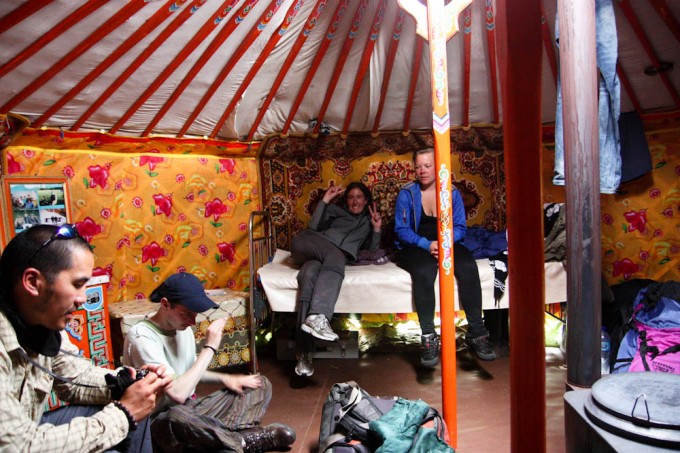
We had a good amount of time to relax and get to know the family and the surroundings at this point. While we thought we would have to get on horses right away, it was a nice break to just take it all in. We soon found out that the family living here was having trouble because a wolf roamed in the nearby hills. It was attacking their goats and sheep. They had been trying to hunt it unsuccessfully for several weeks because it had killed many of their livestock already, and the family depends on their herd for survival.
After hanging around for the morning, our guides and our host family decided it was time to round up the horses and get us moving again. The horses had been set loose the night before so they could graze on the grass, and we saw them up the hill a few hundred yards away. In a land without trees, it’s easy to find your horse. One of the women from the host family attached some reigns to a nearby horse, jumped on it bareback, and took off towards the group of horses in the distance. Another younger guy did the same, but went off at a different angle. They each rode to a different side of the herd, and we watched the two of them manipulate and encourage the loose horses into a group and then drive them towards the rest of us. We then realized that we were just casually standing around the gers, chatting about the weather, while a thundering roar of horses was quickly bearing down on us. Some of the other members of the host family then told us to spread out in a line right in front of the raging herd. Forming a crude human fence, we were told to hold our arms out and try to scare the horses into a large circle. They must have seen the fear in our eyes and called our bluff, because most of the horses ran straight past us. A few decided to stop, though, and the Mongolians grabbed them and tied them up while those on horseback continued the chase. This went on for another half hour before we had rounded up all of the horses. Then we put the saddles back onto them and mounted up for another painful day of riding.
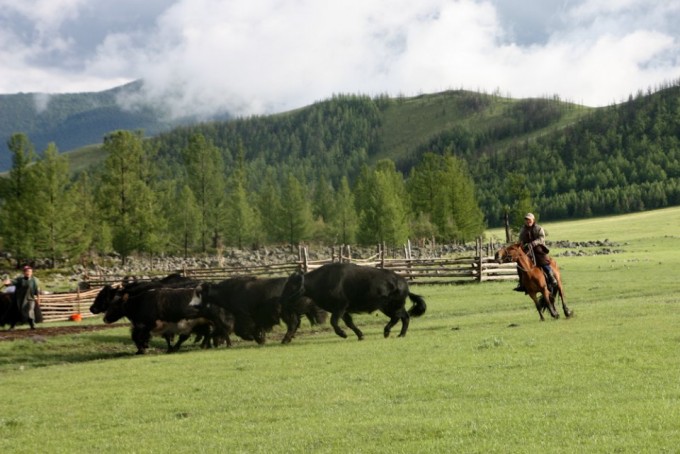
Our butts were even more sore than the day before, but we carried on. The scenery was still magnificent. On this final day of horseback riding, we rode down the middle of a long, wide valley. Up ahead in the distance we could see a set of gers on a low plateau, and Suvdaa said this was our destination for the night. It didn’t look that far away, but our rear ends couldn’t take it anymore. Should we ride fast and hard and experience even more pain for a shorter amount of time? Or should we take it slow and prolong the journey, feeling less pain but for much longer? In the end, it wasn’t really up to me, because my horse did what it wanted, changing speeds inconsistently depending on its mood and distance to the other horses.
That afternoon, after arriving at yet another ger camp, some of our travel companions needed to leave the tour because they had booked onward tickets. We said our goodbyes and shared contact info before they left, and then settled down for dinner. The next morning we were back in the van, seated on the very comfortable seats (which were not saddles!), as Dasha drove us towards a nearby waterfall. Later that night we camped high on a hill overlooking a valley. At this point we had moved beyond the point of seeing Mongolia as some type of surreal place, and accepted it for what it was: an very real and amazing place to camp and explore the countryside. We had learned about the Mongolian way of life and what it takes to survive in this unique and challenging land.
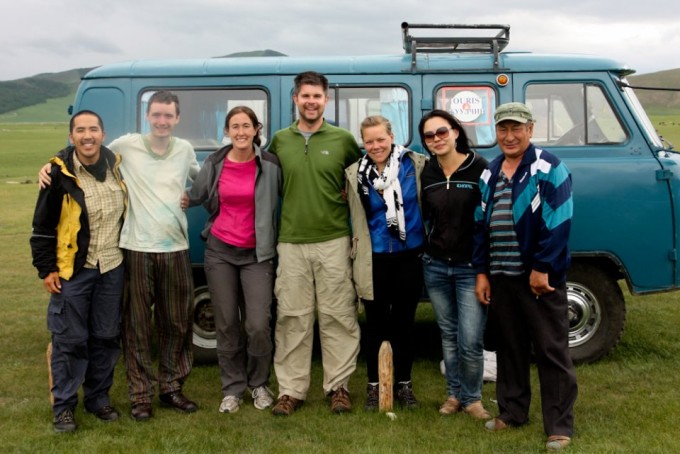
We were now on the part of our journey around the countryside that was looping back towards the capital. With only a few days left, we stopped at a small town with some hot springs, and then another town with a large Buddhist monastery. Now that we were closer to the capital, we began to see more people, and we were even driving on an actual road. About every thirty minutes, a vehicle would pass by. It was like rush hour traffic, Mongolian style.
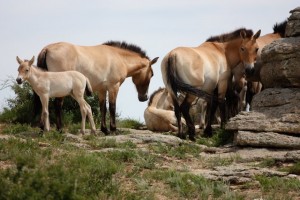
On our final day we visited Hustai National Park, known for an extremely rare species of wild horse, the Takhi. This horse, which is technically not a horse but an entirely different species, had actually become extinct in Mongolia. It could only be found in zoos around the world before the Mongolians decided to reintroduce the species and breed them here in their native environment. Now, over 200 Takhi horses roam freely through the park. We picked up a local park guide at the entrance and drove deep into the park lands. The guide was a young university student who said she was a volunteer at the park. Soon we saw some of the horses up on a hill and began to approach them on foot for a better view and some photos. After walking a good distance, with the horses slowly moving away from us, we got within about 50 yards of the horses. We asked the park guide how close we were allowed to get, and she said that it was against the rules to get closer than 300 meters to the horses. Despite this, she seemed very excited to be so close herself. She said she had never been this close and then pulled out her own camera to take even more pictures. Oh well, so much for the rules. The Takhi horses themselves were beautiful. They all had a beige coloring and larger heads than normal horses. Because of the foresight and organization of the very small Mongolian government, we were able to see a species which had been all but lost.
Driving back into Ulaanbaatar was strange after spending so much time in the empty countryside. Crowds of people walked along the sidewalks below tall and modern glass buildings. We had dinner at an Italian restaurant instead of “cardboard box meat stew.” Readjusting to civilization was awkward. The next day we took in a Mongolian variety show at the very modern concert hall on a wide boulevard in the middle of the city. Music, dancing, tumbling, and a very flexible contortionist entertained us for the evening before we had Indian food for dinner. Everything was just weird, and I was culturally confused.
And then it was time to go. We caught the overnight train back to the Chinese border, and then took a bus back to a very crowded Beijing, concluding our Mongolian Adventure. It might have been rough at times, but it was absolutely worth it.
Find Shanghai Hostels Near the Bund
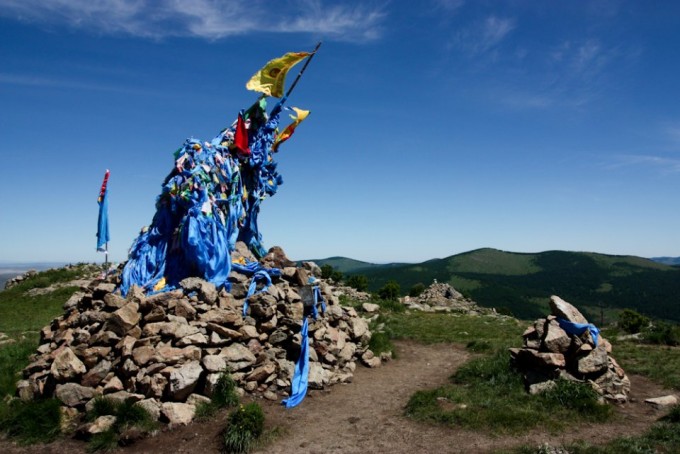
Bryan has visited 56 countries, which is exactly one more country than his wife, and she won’t let him forget it! Also an avid photographer, he enjoys entrenching himself within the local culture in order to learn more about the people of a place. He is the co-founder of Budget Your Trip and loves a good adventure, an exotic meal, or a passionate conversation about global events. And he also loves to find out how much stuff costs.

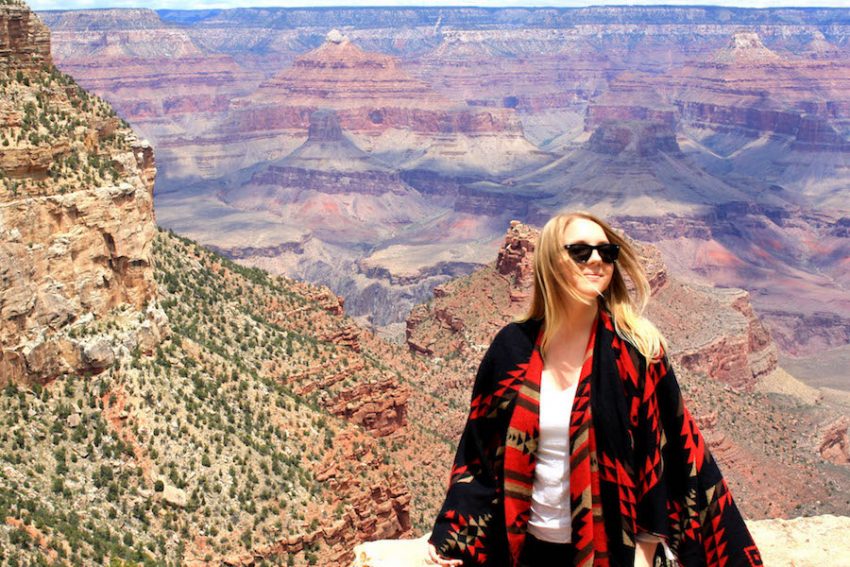
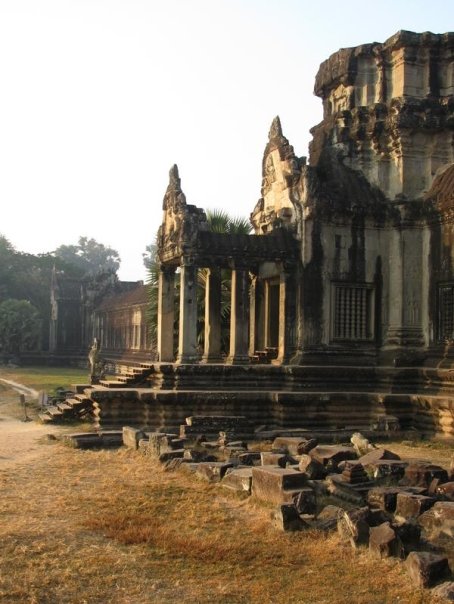
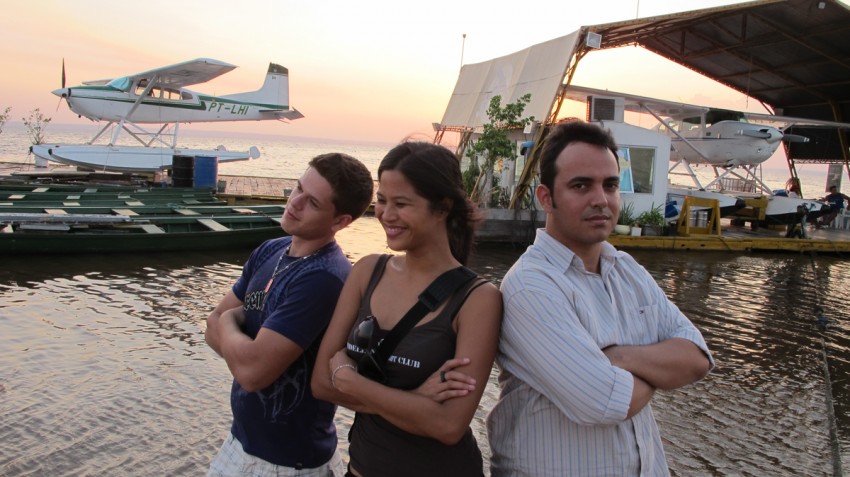
These gers are crazy looking! I don’t think I could have drank the milk either, just reading it made me want to puke! lol